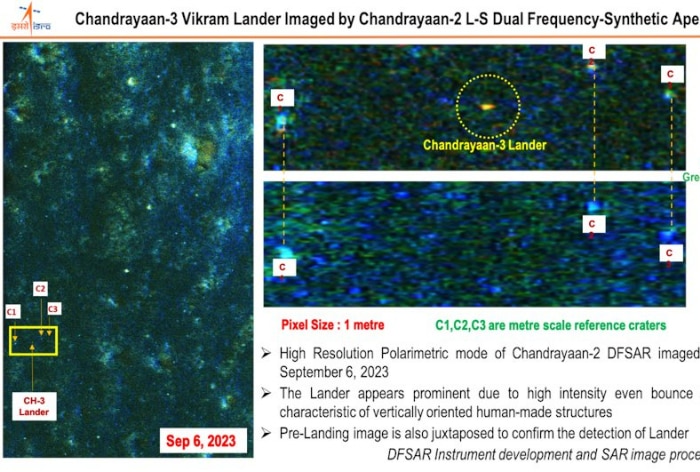
[ad_1]
“Chandrayaan-3 lander is imaged by the Dual-frequency Synthetic Aperture Radar (DFSAR) instrument onboard the Chandrayaan-2 Orbiter on September 6, 2023,” said ISRO.

Chandrayaan-3 Clicked By Chandrayaan-2: The Chandrayaan-3 lander was clicked by the Dual-frequency Synthetic Aperture Radar (DFSAR) instrument onboard the Chandrayaan-2 Orbiter on September 6, 2023, according to the Indian Space Research Organisation (ISRO). The Chandrayaan-2 orbiter had established a two-way connection with the lander module of Chandrayaan-3 days ahead of its soft landing in August.
“Chandrayaan-3 lander is imaged by the Dual-frequency Synthetic Aperture Radar (DFSAR) instrument onboard the Chandrayaan-2 Orbiter on September 6, 2023,” said ISRO.
Another image of the Chandrayaan-3 landing site was clicked by a NASA satellite, Lunar Reconnaissance Orbiter (LRO) recently.
Function Of SAR Instrument
A SAR instrument transmits microwaves in a given frequency band and receives the same, scattered from the surface. Being a radar, it can image even without solar illumination. It can provide both the distance and physical characteristics of the target features. Hence, SAR is utilized for remote sensing of the Earth and other celestial bodies.
About DFSAR
DFSAR is a key scientific instrument onboard the Chandrayaan-2 Orbiter. It employs microwaves in L- and S-band bands. This state-of-the-art instrument offers the best resolution polarimetric images currently on any planetary mission. The long radar wavelength enables DFSAR to explore lunar subsurface features down to a few metres. DFSAR has been beaming high-quality data by imaging the lunar surface, for the last 4 years, with the main focus on the lunar polar science.
Latest About Chandrayaan-3
The Chandrayaan-3 spacecraft is currently near the Moon’s South Pole since its successful soft landing on August 23. India became the fourth country after the US, China, and Russia to have successfully landed on the moon’s surface.
India took a giant leap as the Chandrayaan-3 lander module successfully landed on the moon’s South Pole, making it the first country to have achieved the historic feat and bringing to an end the disappointment over the crash landing of the Chandrayaan-2, four years ago.
Post-landing, the Vikram lander, and the Pragyan rover performed different sets of tasks on the lunar surface, including finding the presence of sulphur and other minor elements, recording relative temperature, and listening to movements around it.
The ISRO put out a 3-dimensional “anaglyph” image of the Chandrayaan-3 Vikram lander from the south pole of the Moon. Anaglyph is a simple visualization of the object or terrain in three dimensions from stereo or multi-view images.
(With agency inputs)
[ad_2]